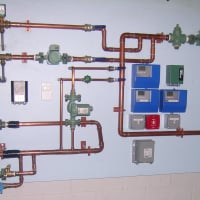Welcome! Here are the website rules, as well as some tips for using this forum.
Need to contact us? Visit https://heatinghelp.com/contact-us/.
Click here to Find a Contractor in your area.
If our community has helped you, please consider making a contribution to support this website. Thanks!
Steam leak
Options

Snowmelt
Member Posts: 1,457
I been doing some work on a steam system, it finally failed at end of season, now they called me to replace it.
The big problem besides not piped correctly is that it was using a lot of water but there was no physical leak. All the returns are visible to the eye. There are no puddle of water anywhere. It’s a rather long as in linnier feet of piping, no water on the ground anywhere, the three leaks that we did find did have water on the ground.
There are roughly 6 - 8 steam traps and one condensation pump.
Can I use a smoke test to try to find a leak?
Can I use air if I cap the vents?
What other alternative would you like to see done?
The big problem besides not piped correctly is that it was using a lot of water but there was no physical leak. All the returns are visible to the eye. There are no puddle of water anywhere. It’s a rather long as in linnier feet of piping, no water on the ground anywhere, the three leaks that we did find did have water on the ground.
There are roughly 6 - 8 steam traps and one condensation pump.
Can I use a smoke test to try to find a leak?
Can I use air if I cap the vents?
What other alternative would you like to see done?
0
Comments
-
The most common place for a steam system to leak is the boiler, unfortunately. Since you are replacing the boiler, that should take care of that one.
The next most common is tired wet returns. The best way to check those is to rig something up so that you can fill them with water -- just the open end of the connection up to the Hartford loop will do nicely -- and fill them. If the water drops... then you have some detective work to do to find the villain (were I doing it, and had three known leaks, I'd probably replace all the wet return piping -- but that's me).
Then after that... steam mains, runouts, and dry returns very rarely leak. Fitting do, now and then. Valves do, rather more often -- and steam vents on radiators often do. You could use air, but you'd have to plug all the steam vents, which is a pain -- and anyway that would tell you you have a leak, but not where.Br. Jamie, osb
Building superintendent/caretaker, 7200 sq. ft. historic house museum with dependencies in New England0 -
with the boiler turned off,
flood the boiler to header height and check under boiler,
flood to mains and vents height in basement and check some more,
vents can leak steam = water
valve stems at rads can leak steak = waterknown to beat dead horses0 -
If the piping is not leaking for sure then the most likely reason for water loss is the steam traps. The traps blow steam which comes out the vent on the condensate pump never to be seen unless your there when the boiler is running0
-
condensate pump,
I missed that,
careful with my flood testing, you may make a mess,
what ed says above alsoknown to beat dead horses0 -
A leaky steam vent is easy to find. Its noisy and steam bellows from it. Check around the house while the system is running to find any leaky vents. They may not show up as water on the ground.I am the walking Deadman
Hydronics Designer
Hydronics is the most comfortable and energy efficient HVAC system.0 -
While redoing some dry return piping on older systems with multiple return pipes, I installed a tee with 24-30" riser pipe on each dry return as soon as it entered the boiler room.
This indicator will allow you to see which section of the building has leaking steam traps and keep that steam out of the cond return pump. From 12' below an inexpensive ($350) FLIR will show the steam fog cloud even if you can not see it with your own eyes.0 -
I replaced all steam vents at end of last season.0
-
Valve stem leaks can be invisible but add up.0
-
Are the pipes insulated? How much of the piping isn't accessible?Burnham IN5PVNI Boiler, Single Pipe with 290 EDR
18 Ounce per Square Inch Gauge
Time Delay Relay in Series with Thermostat
Operating Pressure 0.3-0.5 Ounce per Square Inch0 -
No pipe is insulated, all the pipes are above ground some are in walls but 90% is available0
-
You could try using compressed air and soapy water since most of the system is accessible and the pipes are visible. It'll take some time to do.
I assume this is single pipe system.
If so, remove the radiator vents and main vents and plug them. Also remove the pressuretrol, and drain the boiler. Put a compressed air fitting somewhere on the system, and put 2-3 pounds of pressure in the system. Then use soapy water on all the pipe fittings and radiator joints.
As others have mentioned, the leaks are most likely at unions and valves. If you have a pin hole leak in a pipe, that might be harder to find. You might luck out and hear the air escaping in that case if the space is quiet enough.
My guess is it's several small leaks vs. a single big one.
I did this on my system and I was able to tighten it up. Most of my leaks were at the radiator valves (stems and unions).Burnham IN5PVNI Boiler, Single Pipe with 290 EDR
18 Ounce per Square Inch Gauge
Time Delay Relay in Series with Thermostat
Operating Pressure 0.3-0.5 Ounce per Square Inch0
Categories
- All Categories
- 87.3K THE MAIN WALL
- 3.2K A-C, Heat Pumps & Refrigeration
- 61 Biomass
- 427 Carbon Monoxide Awareness
- 119 Chimneys & Flues
- 2.1K Domestic Hot Water
- 5.8K Gas Heating
- 114 Geothermal
- 165 Indoor-Air Quality
- 3.7K Oil Heating
- 76 Pipe Deterioration
- 1K Plumbing
- 6.5K Radiant Heating
- 395 Solar
- 15.6K Strictly Steam
- 3.4K Thermostats and Controls
- 56 Water Quality
- 51 Industry Classes
- 50 Job Opportunities
- 18 Recall Announcements


